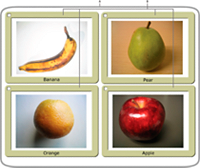If
a DisplayObjectContainer object is deleted from the display list,
or if it is moved or transformed in some other way, each display
object in the DisplayObjectContainer is also deleted, moved, or
transformed.
A display object container is itself a type of display object—it
can be added to another display object container. For example, the
following image shows a display object container,
pictureScreen
,
that contains one outline shape and four other display object containers
(of type PictureFrame):
View full size graphic

-
A.
-
A shape defining the border of the pictureScreen display
object container
-
B.
-
Four display
object containers that are children of the pictureScreen object
In order to have a display object appear in the display list,
you must add it to a display object container that is on the display
list. You do this by using the
addChild()
method
or the
addChildAt()
method of the container object. For
example, without the final line of the following code, the
myTextField
object
would not be displayed:
var myTextField:TextField = new TextField();
myTextField.text = "hello";
this.root.addChild(myTextField);
In this code sample,
this.root
points to the
MovieClip display object container that contains the code. In your
actual code, you may specify a different container.
Use the
addChildAt()
method to add the child
to a specific position in the child list of the display object container.
These zero-based index positions in the child list relate to the
layering (the front-to-back order) of the display objects. For example,
consider the following three display objects. Each object was created from
a custom class called Ball.
The layering of these display objects in their container can
be adjusted using the
addChildAt()
method. For
example, consider the following code:
ball_A = new Ball(0xFFCC00, "a");
ball_A.name = "ball_A";
ball_A.x = 20;
ball_A.y = 20;
container.addChild(ball_A);
ball_B = new Ball(0xFFCC00, "b");
ball_B.name = "ball_B";
ball_B.x = 70;
ball_B.y = 20;
container.addChild(ball_B);
ball_C = new Ball(0xFFCC00, "c");
ball_C.name = "ball_C";
ball_C.x = 40;
ball_C.y = 60;
container.addChildAt(ball_C, 1);
After executing this code, the display objects are positioned
as follows in the
container
DisplayObjectContainer
object. Notice the layering of the objects.
To reposition an object to the top of the display list, simply
re-add it to the list. For example, after the previous code, to
move
ball_A
to the top of the stack, use this line
of code:
container.addChild(ball_A);
This code effectively removes
ball_A
from its
location in
container
’s display list, and re-adds
it to the top of the list—which has the end result of moving it
to the top of the stack.
You can use the
getChildAt()
method to verify
the layer order of the display objects. The
getChildAt()
method
returns child objects of a container based on the index number you
pass it. For example, the following code reveals names of display
objects at different positions in the child list of the
container
DisplayObjectContainer
object:
trace(container.getChildAt(0).name); // ball_A
trace(container.getChildAt(1).name); // ball_C
trace(container.getChildAt(2).name); // ball_B
If you remove a display object from the parent container’s child
list, the higher elements on the list each move down a position
in the child index. For example, continuing with the previous code,
the following code shows how the display object that was at position
2 in the
container
DisplayObjectContainer moves to
position 1 if a display object that is lower in the child list is
removed:
container.removeChild(ball_C);
trace(container.getChildAt(0).name); // ball_A
trace(container.getChildAt(1).name); // ball_B
The
removeChild()
and
removeChildAt()
methods
do not delete a display object instance entirely. They simply remove
it from the child list of the container. The instance can still
be referenced by another variable. (Use the
delete
operator
to completely remove an object.)
Because a display object has only one parent container, you can
add an instance of a display object to only one display object container.
For example, the following code shows that the display object
tf1
can
exist in only one container (in this case, a Sprite, which extends
the DisplayObjectContainer class):
tf1:TextField = new TextField();
tf2:TextField = new TextField();
tf1.name = "text 1";
tf2.name = "text 2";
container1:Sprite = new Sprite();
container2:Sprite = new Sprite();
container1.addChild(tf1);
container1.addChild(tf2);
container2.addChild(tf1);
trace(container1.numChildren); // 1
trace(container1.getChildAt(0).name); // text 2
trace(container2.numChildren); // 1
trace(container2.getChildAt(0).name); // text 1
If you add a display object that is contained in one display
object container to another display object container, it is removed
from the first display object container’s child list.
In addition to the methods described above, the DisplayObjectContainer
class defines several methods for working with child display objects,
including the following:
-
contains()
: Determines whether a display
object is a child of a DisplayObjectContainer.
-
getChildByName()
: Retrieves a display object
by name.
-
getChildIndex()
: Returns the index position
of a display object.
-
setChildIndex()
: Changes the position of
a child display object.
-
removeChildren()
: Removes multiple child
display objects.
-
swapChildren()
: Swaps the front-to-back
order of two display objects.
-
swapChildrenAt()
: Swaps the front-to-back
order of two display objects, specified by their index values.
For more information, see the relevant entries in the
ActionScript 3.0 Reference for the Adobe
Flash Platform
.
Recall that a display object that is off the display list—one
that is not included in a display object container that is a child
of the Stage—is known as an
off-list
display object.
